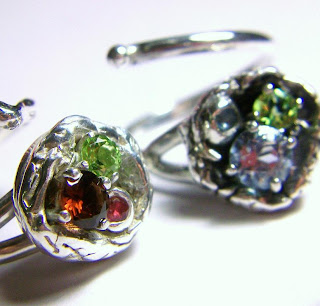Feb 13, 2012
Silver Overlay Paste - This stuff is Magic
Silver Overlay Paste has so many uses and I haven’t explored them all yet. I have had the chance to use it for embedding sterling in metal clay as well as use it for “soldering” pieces together. Here are my notes.
Embedding Sterling in Metal Clay
I have been successful at embedding sterling silver in Art Clay Silver using the slow dry low fire clay formula. Using a torch, carefully watching the color of the orange glow in the sterling, it is possible to incorporate sterling into metal clay designs. Now, I’ve discovered Silver Overlay Paste which gives even better results with such a strong bond allowing me to make the most complex designs yet.
Overlay paste is not regular paste and it is not oil paste.
Regular paste can be mixed at home by adding water to fresh clay (or dried clay that has been crushed) to dilute the clay to a paste, thick or thin.
Oil paste can also be mixed at home by adding essential oil (like lavender) to regular paste.
Here are only some uses for these pastes:
Regular Paste - use it on fresh or dried clay, not yet fired. Paint leaves, fill molds, many uses.
Oil Paste - use it to join fired clay to fresh or fired clay. Must be fired at full temp for full time.
Overlay Paste - specifically formulated to fire at lower temp, 1200 degrees. Great on ceramic, porcelain, and the first point of contact between any objects embedded in clay. Very friendly to torch users.
I use two different methods for embedding sterling depending on if I am using the overlay paste or not.
Without Overlay Paste:
The sterling will need to be “gripped” by the clay so I make sure the part that is going into the clay has a bend, a loop, or I hack it up a little with a file or cutters. This gives the clay something to grab onto as it fires and shrinks around the sterling. I also torch the sterling to get it to a deep gray black color, then pickle the piece back to silvery color. I use a little regular paste on the part that is going into the clay and push it into the clay and let it dry.
With Overlay Paste:
I torch the sterling, pickle. Paint or dab the overlay paste on the sterling that will be attached and press it in place. Both methods might require a little filing or sanding before firing. Both methods can be torched, and watching the color in the sterling has been key. Sterling has a melting point somewhere around 1650 degrees. If you have ever balled the end of a wire, for an earring perhaps, you’ve seen the salmon color turn to bright orange as the end balls. That color will assist you when torching, as you do not want to get to the bright orange color and melt your sterling. You also want to keep the temperature hot enough to properly sinter the metal clay. If careful, it can be done!
Here is an example of sterling embedded without overlay paste. This is my Bird Nest Mothers Ring. I embed the prong settings and the ring band into the fresh clay, let it dry and torch.
Here is an example of sterling embedded with overlay paste. This ring has 8 joins which means 8 places that needed two parts to join together. I used a metal clay heart for the ring top that was fired alone first. I then made a bezel with sterling gallery wire, not joining the seam. I used overlay paste to attached the heart to the top of the gallery wire, overlay paste on the bezel seam, overlay paste on the bottom of the gallery wire and embedded that into a rolled out piece of clay. I trimmed the clay around the bezel, outside and inside, let it dry and fired it all together. From this point, no solder was used. I was free to solder the ring band and prong settings, as well as resize the ring band using solder, no worries that it would collapse from the heat.
Overlay Paste Can Be Used Like Solder and Unlike Solder
This overlay paste is very much like soldering, because it joins pieces together. It has a bright silver color, better than silver solder.
It is very different in that is has to dry first, but it can fill gaps, it holds pieces together as they join like glue, no worries about undoing previous joins. No flux used and the pieces don’t have to be perfectly flush to join. The list goes on. The overlay paste works best with joining larger surfaces and may not work well on tiny spots. For example, resizing a ring only requires the tiniest join, best done with solder. My heart ring top had a continuous line of overlay paste which bonded perfectly to the sterling bezel wire.
For anyone that is learning to solder, this overlay paste is something that I recommend you consider to learn, too!
Overlay paste is amazing, strong, and versatile. I am hoping that this post will give other metal clay artists a fresh look at something that might have been overlooked before as “just another paste”.
Labels:
art clay silver,
bird nest,
embed sterling,
etsy,
heart ring,
how to,
metal clay,
metal clay heads,
metal clay rings,
mothers ring,
overlay paste,
silver metal clay,
soldering,
torch,
york avenue studio
Subscribe to:
Post Comments (Atom)




No comments:
Post a Comment